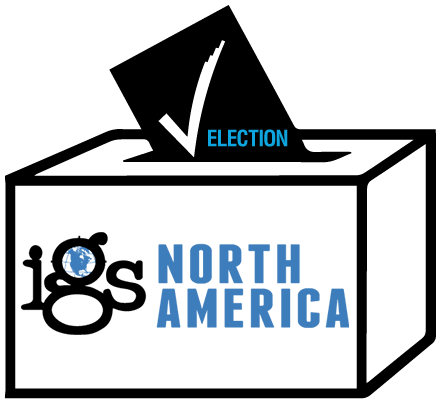 The IGS-NA 2017 Election will be held from 3 – 27 January 2017. Ballots will be cast electronically, each member in good standing will receive an electronic ballot to the email address on file with the IGS-NA. Each voting member may cast one vote each forPresident Elect and Treasurer. There are 3 open Vice Presidential seats on the board. Each IGS-NA Member in good standing may cast up to 3 votes for theVice-Presidential seats, the order of selection of up to 3 candidates does not affect the weight of the vote – each vote shall count as one point for the candidate. The 3 candidates with the highest number of votes will be the successful candidates.
The IGS-NA 2017 Election will be held from 3 – 27 January 2017. Ballots will be cast electronically, each member in good standing will receive an electronic ballot to the email address on file with the IGS-NA. Each voting member may cast one vote each forPresident Elect and Treasurer. There are 3 open Vice Presidential seats on the board. Each IGS-NA Member in good standing may cast up to 3 votes for theVice-Presidential seats, the order of selection of up to 3 candidates does not affect the weight of the vote – each vote shall count as one point for the candidate. The 3 candidates with the highest number of votes will be the successful candidates.
If you have any questions about the voting process or any technical issues with the voting system you may contact:
BeckySlaybaugh | 561.768.9487 | info@igs-na.org
If you have any questions about the nominations please contact Immediate Past President, Robert (Bob) Mackey | bmackey@s2li.com.
The IGS-North America in concert with IFAI and the GeoInstitute will host Geotechnical Frontiers 2017. This unique conference brings together professionals from three different, leading organizations in the geotechnical, geosynthetic and environmental engineering communities. If you are looking for an event with an extensive technical scope and international networking this is the event for you!
IGS North America members receive discounted pricing, if your not a member Join Now to receive this benefit!
Connect with more than 2,000 geotechnical professionals representing all facets of the geotechnical industry during Geotechnical Frontiers 2017. Immerse yourself in a sea of knowledge through a full schedule of short courses, workshops, training lectures, plenary sessions, technical papers, and panel discussions presented by experts in the field. Walk the show floor to see the latest developments in geotechnical products and services offered by the industry’s top companies and organizations. Plan for plenty of opportunities to network and socialize.
The trade show and all of events and education will be held at the Hyatt Regency Orlando, convenient to airports, hotels and major attractions.
Visit the conference web site to learn more: http://geotechnicalfrontiers.com
 As 2016 draws to a close it’s time to start thinking about 2017 and the election of Members to serve on the next IGS North America Board. The Mission of IGS-NA is to provide leadership in advancing geosynthetics education and research to attain their appropriate and widespread use as engineering materials as the Chapter of the International Geosynthetic Society (IGS) for the United States of America and Canada.
As 2016 draws to a close it’s time to start thinking about 2017 and the election of Members to serve on the next IGS North America Board. The Mission of IGS-NA is to provide leadership in advancing geosynthetics education and research to attain their appropriate and widespread use as engineering materials as the Chapter of the International Geosynthetic Society (IGS) for the United States of America and Canada.
2017 will be an exciting year with IGS-NA. If you are interested in helping to develop the programming, services and leadership offered by IGS-NA, I encourage you to consider standing for office.
Seats open for the upcoming election are:
Important Dates & Deadlines
To nominate someone or yourself please email the requested information to Info@IGS-NA.org. Please include your: name, title, company/institution/organization name, address, email address & phone number as well as a 150 word description about your involvement in the geosynthetics industry and your reason(s) for running for the seat.
If you have any questions or need more information please contact the Chairman of the IGS-NA Nomination Committee and Past-President Bob Mackey (bmackey@s2li.com).
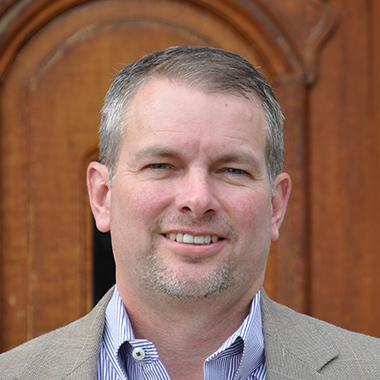 Kind regards,
Kind regards,
John Henderson
President – IGS North America
J.Henderson@Tencate.com
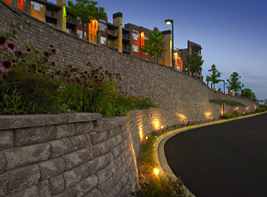 The IGS North America (IGS-NA) and the National Concrete Masonry Association (NCMA) are co-hosting an October 26 webinar. The topic: Segmental Retaining Wall Best Practices. The session will be held from 1:00 – 2:30 pm (EDT) and is worth 1.5 PDHs.
The IGS North America (IGS-NA) and the National Concrete Masonry Association (NCMA) are co-hosting an October 26 webinar. The topic: Segmental Retaining Wall Best Practices. The session will be held from 1:00 – 2:30 pm (EDT) and is worth 1.5 PDHs.
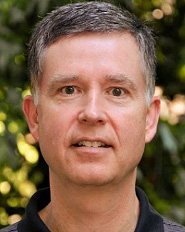 Scott Vollmer, P.E. (Oldcastle) will serve as the instructor. He brings an extensive background in retaining walls and geosynthetics, and he also is an educational leader, having regularly taught NCMA’s Level 1 SRW Contractor Certification Course.
Scott Vollmer, P.E. (Oldcastle) will serve as the instructor. He brings an extensive background in retaining walls and geosynthetics, and he also is an educational leader, having regularly taught NCMA’s Level 1 SRW Contractor Certification Course.
SEGMENTAL RETAINING WALL BEST PRACTICES
The 90-minute presentation is based on NCMA’s recently released Segmental Retaining Wall Best Practices Guide. The webinar presentation will explore best practices for design, specification, construction, and inspection for segmental retaining walls. The work in the guide and which will be presented by Vollmer is based on over 20 years of industry experience.
The takeaways for webinar participants include:
COST TO PARTICIPATE
IGS-NA, IGS, and NCMA members qualify for reduced registration fee: USD $50. The cost to non-members is USD $75.
Learn more and register at the IGS-NA website:
LEARN MORENCMA SRW BEST PRACTICES GUIDE
Want to get a jump on the webinar? Download a copy of NCMA’s Segmental Retaining Wall Best Practices Guide (PDF) now and get prepared for the webinar discussion.
Of the publication, NCMA writes:
This Guide reflects a compendium of contemporary
knowledge collected over several decades that highlight proven solutions using segmental retaining walls (SRWs). The information and recommendations presented in this Guide are intended to augment the design practices and recommendations contained within NCMA’s Design Manual for Segmental Retaining Walls, but are equally applicable regardless of the design methodology selected. The creation of this resource was driven by the establishment of NCMA’s Zero Failures Initiative–an industry-wide program to educate owners, designers, site civil engineers, geotechnical engineers, and installers of SRW systems on the industry’s recommended practices and to promote a philosophy that strives for ensuring successful wall performance.
The North American Geosynthetics Society and the Geosynthetic Materials Association co-sponsored a day and half seminar in Syracuse, NY on the design of waste containment systems on March 22 and 23rd. Over 100 attendees with representatives from the New York State Dept. of Environmental Conservation, the New Jersey State Dept. of Environmental Protection, the Maryland State Dept. of the Environment, and US EPA’s Region 2 Headquarters, graduate students and their professor from Syracuse University, several landfill owners and operators, design consultants, contractors, and manufacturers/suppliers of various geosynthetic materials also participated.

Left, Dave Suits, NAGS Executive Director, & Right, Jonathan Curry, GMA Division Director, Welcoming Attendees
Dr. Richard Brachman, Queen’s University, and president-elect of NAGS, was the lead lecturer. Robert Phaneuf, NYS DEC’s Division of Materials Management, presented overviews of the proposed revisions to New York State’s solid waste regulations, 6 NYCRR Part 360, as they relate to landfill liner and final cover systems. Mr. Phaneuf also provided a brief introduction of the points of interest from a New York State regulatory perspective for each of Dr. Brachman’s design topic lectures. Abigail Beck, TRI Environmental, provided information on electrical leak detection with a video demonstration of the test, and guidance in designing an electrical leak detection program. The program concluded with a panel representing three consultant firms presenting “Take Home Points” from the design consultant perspective. The panel members included Cory McDowell, representing Baron and Loguidice, D.P.C, Bradford Smith, representing GHD Consulting Services, Inc., and Mark Swyka, representing Cornerstone Environmental Group.

L-R, Robert Phaneuf, Abigail Beck, Richard Brachman, Cory McDowell, Mark Swyka, Brad Smith
Providing sponsorships from the Geosynthetic Materials Association membership were GSE, Inc., Agru Americas, Titan, and Terrifix. Sponsorship included the opportunity for table top displays¸ along with a fifteen-minute time slot during meals to speak about projects that their companies had been involved with. Upon adjourning the seminar, Mr. Phaneuf expressed appreciation on behalf of the Division of Materials Management to the seminar sponsors (NAGS and GMA) for bringing this training opportunity to a New York State location and providing a venue where both regulators and design engineers have an opportunity learn together at a very reasonable cost.
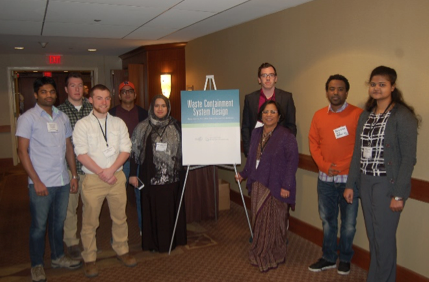
Syracuse University Students w/Dr. Shobha Bhatia on the right next to the sign
“We found the technical seminar both comprehensive and enjoyable. As graduate students, it was stimulating as well as valuable to not only learn about the proper selection, design and construction of geosynthetic materials being used in today’s landfill liner and final cover systems but also be cognizant of the many reasons for failures encountered in real projects. The opportunity enabled us to widen our knowledge of the fundamentals when it comes to landfill engineering, design, and construction—while complementing that knowledge with the technological tools, techniques, and advances available to us today, as well as get the unique opportunity to understand the many regulatory concerns associated with each area of discussion.”
A comment from one of the regulators in attendance: “Simply the best professional technical training opportunity that I have had while being at the DEC”.

Meal and Networking Time
Instructor: GARY ROSS
Oldcastle APG
Wednesday, 13 April 2016 – 10:15 am – 1:15pm
“Smart Prospecting, Simplified”
When planning your staff travel, please consider which members would benefit from this complimentary, 3-hour sales workshop held immediately after the close of the exhibition.
GeoAmericas 2016 is proud to present a bonus session for exhibitors! Attend a 3-hour sales workshop led by Gary Ross, to be held immediately after the close of the exhibit hall.
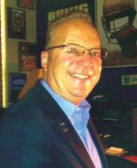 Gary Ross is the Director of Sales Training & Coaching and is a Motivational Speaker for Oldcastle APG. He holds a Bachelor of Science Degree in Human Resource Management from Palm Beach Atlantic University, and earned his certificate in Supervisory Development from the University of Notre Dame.
Gary Ross is the Director of Sales Training & Coaching and is a Motivational Speaker for Oldcastle APG. He holds a Bachelor of Science Degree in Human Resource Management from Palm Beach Atlantic University, and earned his certificate in Supervisory Development from the University of Notre Dame.
Prior to his role as Director of Sales Training & Coaching, Gary was the Vice President of Sales & Marketing for Coastal, an Oldcastle Company based in Florida. He has over 38 years of sales experience including 13 years in Sales Management.
Gary resides in West Palm Beach, Florida with his wife, Daryl.
The Sales Workshop – “Smart Prospecting, Simplified” will focus on:
Full information on GeoAmericas 2016, including registration, venue, and social/networking opportunities can be found at www.GeoAmericas2016.org.
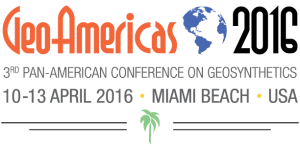
Full information on GeoAmericas 2016, including registration, venue, and social/networking opportunities can be found at www.GeoAmericas2016.org.

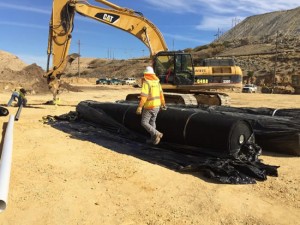 We open the week with an unexpected gift: The early registration discount for GeoAmericas 2016 has been extended to January 29. The conference, which is the 3rd Pan-American Conference on Geosynthetics, will be held 10 – 13 April 2016 at the Loews Miami Beach Hotel in Miami.
We open the week with an unexpected gift: The early registration discount for GeoAmericas 2016 has been extended to January 29. The conference, which is the 3rd Pan-American Conference on Geosynthetics, will be held 10 – 13 April 2016 at the Loews Miami Beach Hotel in Miami.
Highlights for the event include:
Additionally, the conference will feature a large range of meetings from essential organizations in the geotechnical engineering field. They include the International Geosynthetics Society (IGS) Council, the Geosynthetic Institute (GSI), the International Association of Geosynthetic Installers (IAGI), the Fabricated Geomembrane Institute (FGI), the Geosynthetic Materials Association (GMA), the Erosion Control Technology Council (ECTC), the International Erosion Control Association (IECA) Ibero-American Chapter, and the Federation of International Geo-Engineering Societies (FedIGS).
All activities for GeoAmericas 2016 will take place on Miami’s historic South Beach at the five-star Loews Miami Beach Hotel. The 790-room venue is just 20 minutes from Miami International Airport and 35 minutes from Fort Lauderdale International Airport. The Loews offers direct beach access and concierge service in multiple languages.
More than 60% of the room block has been reserved. Organizers encourage all bookings to take place online. The BOOK TODAY link on the GeoAmericas 2016 venue page should be used in order to get the special conference rate.
A few sponsorship and advertising opportunities are available. For questions regarding sponsorship and advertising opportunities with GeoAmericas 2016 or its publishing partner (Geosynthetica), contact André Lacerda, andre@geosynthetica.net, +1 561 570 1061.
**
Visit www.geoamericas2016.org for the latest conference information.
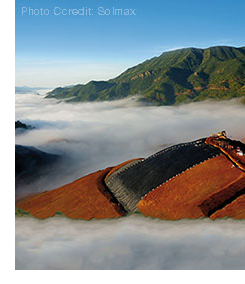 The 3rd Pan-American Conference on Geosynthetics (GeoAmericas 2016) will be held 10 – 13 April 2016 in Miami at the Loews Miami Beach Hotel. This quadrennial regional conference from the International Geosynthetics Society (IGS) features 3.5 days of high-quality geotechnical and civil engineering short courses, technical sessions, panel discussions, training lectures, keynote addresses, and networking in the international exhibit hall.
The 3rd Pan-American Conference on Geosynthetics (GeoAmericas 2016) will be held 10 – 13 April 2016 in Miami at the Loews Miami Beach Hotel. This quadrennial regional conference from the International Geosynthetics Society (IGS) features 3.5 days of high-quality geotechnical and civil engineering short courses, technical sessions, panel discussions, training lectures, keynote addresses, and networking in the international exhibit hall.
Mining is one of the conference’s cornerstone topics.
Geosynthetic materials are essential to the economical and environmental performance of mining operations. Geosynthetic technologies can be used to enhance infrastructure and improve processes. They provide more productive and robust facilities with higher yields.
Geogrids efficiently improve the integrity of unpaved access roads to prevent costly failures under heavy loads and in poor weather.
Geomembranes increase the yield and flow from heap leach pads and liquor trenches.
Geotextiles, geocomposite drainage materials, geosynthetic clay liners, and other geosynthetics perform vital functions, enhance drainage and venting, improve the stability of berms around tailings, etc.
Attendees of GeoAmericas will learn why soil reinforcement is more important than ever to the success of mining and how geosynthetic liners and covers have dramatically and beneficially changed the economics and performance of heap leaching for gold, copper, uranium, and other materials. With multiple courses and sessions to draw upon, GeoAmericas gives participants ready-to-use strategies and access to geosynthetic designers, suppliers, and installers from throughout the Americas.
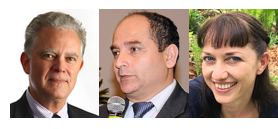 Highlights for mining professionals include:
Highlights for mining professionals include:
 Keynote lecture by Dr. Robert Koerner on “Lifetime Predictions of Exposed Geotextiles and Geomembranes”
Keynote lecture by Dr. Robert Koerner on “Lifetime Predictions of Exposed Geotextiles and Geomembranes”
Full information on GeoAmericas 2016, including registration, venue, and social/networking opportunities can be found at www.GeoAmericas2016.org.
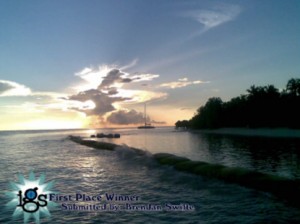 The 3rd Pan-American Conference on Geosynthetics (GeoAmericas 2016) will be held 10 – 13 April 2016 in Miami at the Loews Miami Beach Hotel. This quadrennial regional conference from the International Geosynthetics Society (IGS) features 3.5 days of high-quality geotechnical and civil engineering short courses, technical sessions, panel discussions, training lectures, keynote addresses, and networking in a sold out international exhibit hall.
The 3rd Pan-American Conference on Geosynthetics (GeoAmericas 2016) will be held 10 – 13 April 2016 in Miami at the Loews Miami Beach Hotel. This quadrennial regional conference from the International Geosynthetics Society (IGS) features 3.5 days of high-quality geotechnical and civil engineering short courses, technical sessions, panel discussions, training lectures, keynote addresses, and networking in a sold out international exhibit hall.
Geosynthetic materials are used extensively in coastal protection projects. The modern geotextiles industry, in fact, emerged in the 1950s in response to flooding in the Netherlands and tropical storm damage in the United States. Since then, a large industry and innovative coastal designs have come along. Geosynthetic tubes and containers provide dewatering and solids separation for large-scale dredging operations and the construction of artificial islands. They build up dune systems for hurricane defense and create artificial reefs. Geotextiles and affiliated gabion systems provide shoreline stabilization and erosion control. Geosynthetic bags provide scour protection for shorelines, infrastructure (e.g., ports), and even off-shore wind turbines. Geosynthetics reinforce levees, enhance the sustainability of waterfront construction, and provide highly effective, economical solutions to long-term coastal engineering goals.
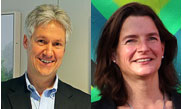 GeoAmericas 2016 features multiple opportunities for coastal protection professionals. Just some of the technical offerings well suited to engineers working in coastal protection include:
GeoAmericas 2016 features multiple opportunities for coastal protection professionals. Just some of the technical offerings well suited to engineers working in coastal protection include:
 Training lectures on embankments on soft soils
Training lectures on embankments on soft soils
Full information on GeoAmericas 2016, including registration, venue, and social/networking opportunities can be found at www.GeoAmericas2016.org.
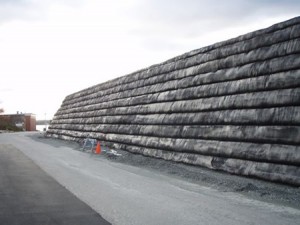 The Young Professionals Program at GeoAmericas 2016 has announced its GeoPrediction Competition. This team-based event will focus on predicting the face displacement of an MSE wall constructed with poorly draining backfill. The objective of the GeoPrediction Competition is to develop an accurate prediction of the behavior of a geotechnical system involving geosynthetics, given detailed information regarding subsurface, boundary, and initial conditions, as well as the geotechnical, structural, and hydraulic loading.
The Young Professionals Program at GeoAmericas 2016 has announced its GeoPrediction Competition. This team-based event will focus on predicting the face displacement of an MSE wall constructed with poorly draining backfill. The objective of the GeoPrediction Competition is to develop an accurate prediction of the behavior of a geotechnical system involving geosynthetics, given detailed information regarding subsurface, boundary, and initial conditions, as well as the geotechnical, structural, and hydraulic loading.
The use of any available geotechnical software and empirical correlations is allowed, as is the development of a simple, accurate computer code for making this prediction.
Questions are welcomed. Email GeoAmericas2016youngmembers@gmail.com.
Eligibility, deadline, and the MSE problem description follows.
 Eligibility: A Geosynthetics Prediction Team will consist of one or two younger members. There is no limit on the number of teams from a given institution or company.
Eligibility: A Geosynthetics Prediction Team will consist of one or two younger members. There is no limit on the number of teams from a given institution or company.
Submittal: Each Geosynthetics Prediction Team will submit a Geosynthetics Prediction Report containing, a minimum, the following information:
Judging: The submitted Geosynthetics Prediction reports will be judged and ranked by a panel of geotechnical engineers. The judging will be based on the criteria listed below.
Announcement: The top three reports will be ranked by the panel and will be presented with awards during the IGS awards ceremony at GeoAmericas 2016.
Questions: Send any questions to GeoAmericas2016youngmembers@gmail.com.
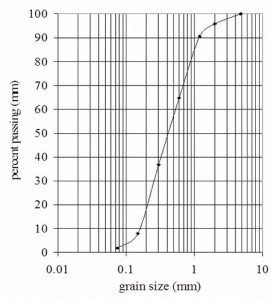 PROBLEM DESCRIPTION & AVAILABLE DATA
PROBLEM DESCRIPTION & AVAILABLE DATA
A geotextile-reinforced prototype mechanically-stabilized earth (MSE) wall was constructed using wrap-around facing with a width of 4m, a height of 4m and a length of 4m. The wall was built with 10 geotextile layers evenly spaced at 0.40m vertically. The reinforcement length was equal to 3.0m. The MSE wall was constructed atop a firm foundation that can be assumed to be rigid with first geotextile layer placed at the ground level. In the design, the reduction factors against creep, durability and installation damage were taken as 1.0. The wrap-around system was assembled using metallic supports and wood boards, for a final angle of 78o from horizontal, resulting in a face slope of 5V:1H. The geotextile material used in the wall was a short-fiber needle-punched polyester non-woven geotextile with the following characteristics:
Backfill soil consisted of a fine to medium well-graded sand which was compacted using a vibratory plate hammer. The grain size distribution of backfill soil is presented in Figure 1. The maximum and minimum void ratios, emax and emin were 0.70 and 0.46. The backfill soil was compacted to a target relative density of 80% which corresponds to a void ratio of 0.51 and dry unit weight of 17.7 kN/m3. The backfill was placed in the field at a gravimetric water content of 5.0%. The soil has a drained friction angle of 33°.
Goal
Estimate the deflections of the wall face as a function of wall height due to the wall’s self-weight immediately after construction.
**
VISIT THE GEOAMERICAS 2016 WEBSITE for more information on the Young Professionals Program, the International Geosynthetics Society (IGS), short courses, and much more.